MAZDA MODEL 6 2005 (in English) Workshop Manual
Manufacturer: MAZDA, Model Year: 2005, Model line: MODEL 6, Model: MAZDA MODEL 6 2005Pages: 340, PDF Size: 3.73 MB
Page 51 of 340
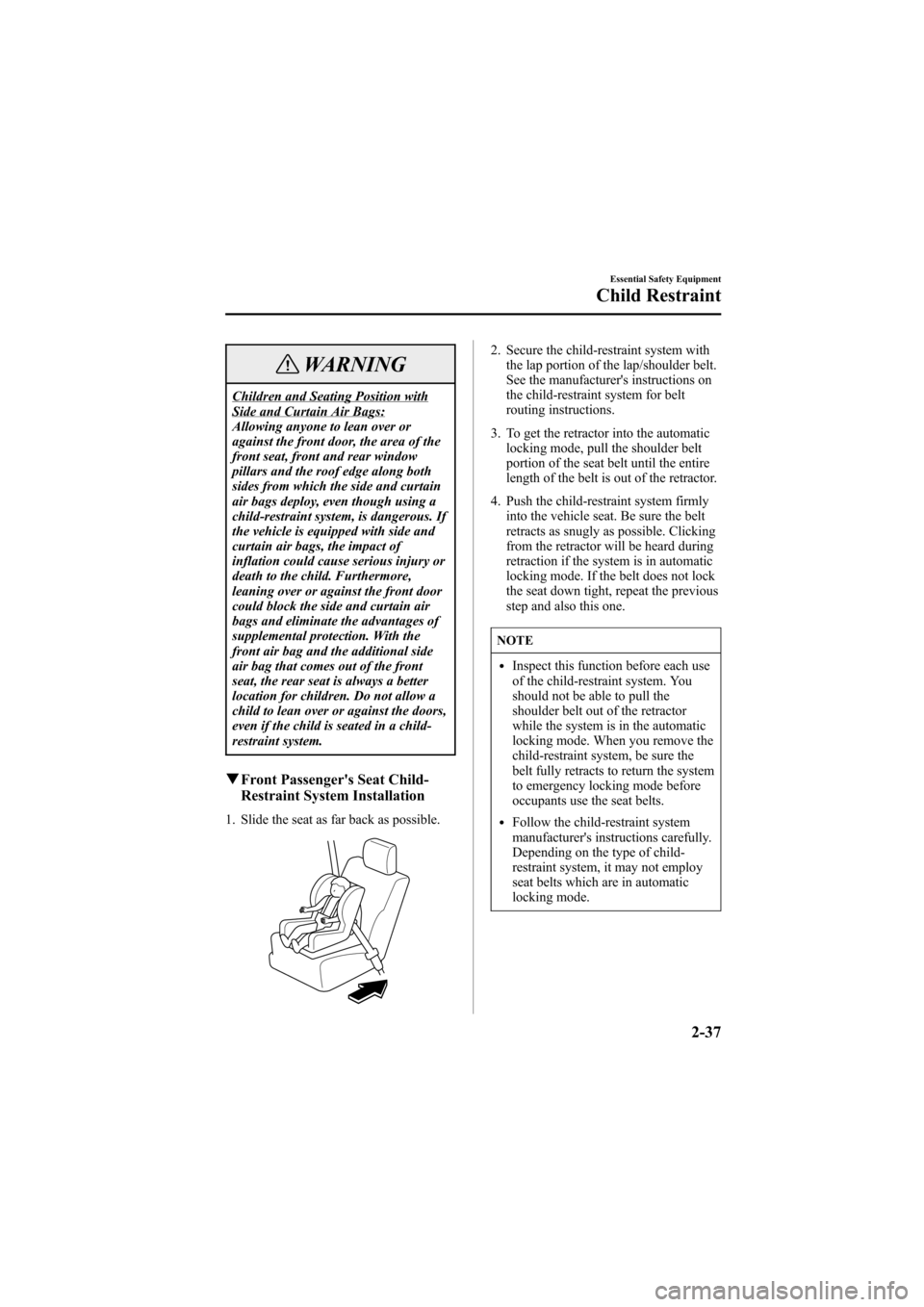
Black plate (51,1)
WARNING
Children and Seating Position withSide and Curtain Air Bags:
Allowing anyone to lean over or
against the front door, the area of the
front seat, front and rear window
pillars and the roof edge along both
sides from which the side and curtain
air bags deploy, even though using a
child-restraint system, is dangerous. If
the vehicle is equipped with side and
curtain air bags, the impact of
inflation could cause serious injury or
death to the child. Furthermore,
leaning over or against the front door
could block the side and curtain air
bags and eliminate the advantages of
supplemental protection. With the
front air bag and the additional side
air bag that comes out of the front
seat, the rear seat is always a better
location for children. Do not allow a
child to lean over or against the doors,
even if the child is seated in a child-
restraint system.
qFront Passenger's Seat Child-
Restraint System Installation
1. Slide the seat as far back as possible.
2. Secure the child-restraint system with
the lap portion of the lap/shoulder belt.
See the manufacturer's instructions on
the child-restraint system for belt
routing instructions.
3. To get the retractor into the automatic
locking mode, pull the shoulder belt
portion of the seat belt until the entire
length of the belt is out of the retractor.
4. Push the child-restraint system firmly
into the vehicle seat. Be sure the belt
retracts as snugly as possible. Clicking
from the retractor will be heard during
retraction if the system is in automatic
locking mode. If the belt does not lock
the seat down tight, repeat the previous
step and also this one.
NOTE
lInspect this function before each use
of the child-restraint system. You
should not be able to pull the
shoulder belt out of the retractor
while the system is in the automatic
locking mode. When you remove the
child-restraint system, be sure the
belt fully retracts to return the system
to emergency locking mode before
occupants use the seat belts.
lFollow the child-restraint system
manufacturer's instructions carefully.
Depending on the type of child-
restraint system, it may not employ
seat belts which are in automatic
locking mode.
Essential Safety Equipment
Child Restraint
2-37
Mazda6_8T56-EC-04G_Edition2 Page51
Monday, November 15 2004 4:32 PM
Form No.8T56-EC-04G
Page 52 of 340
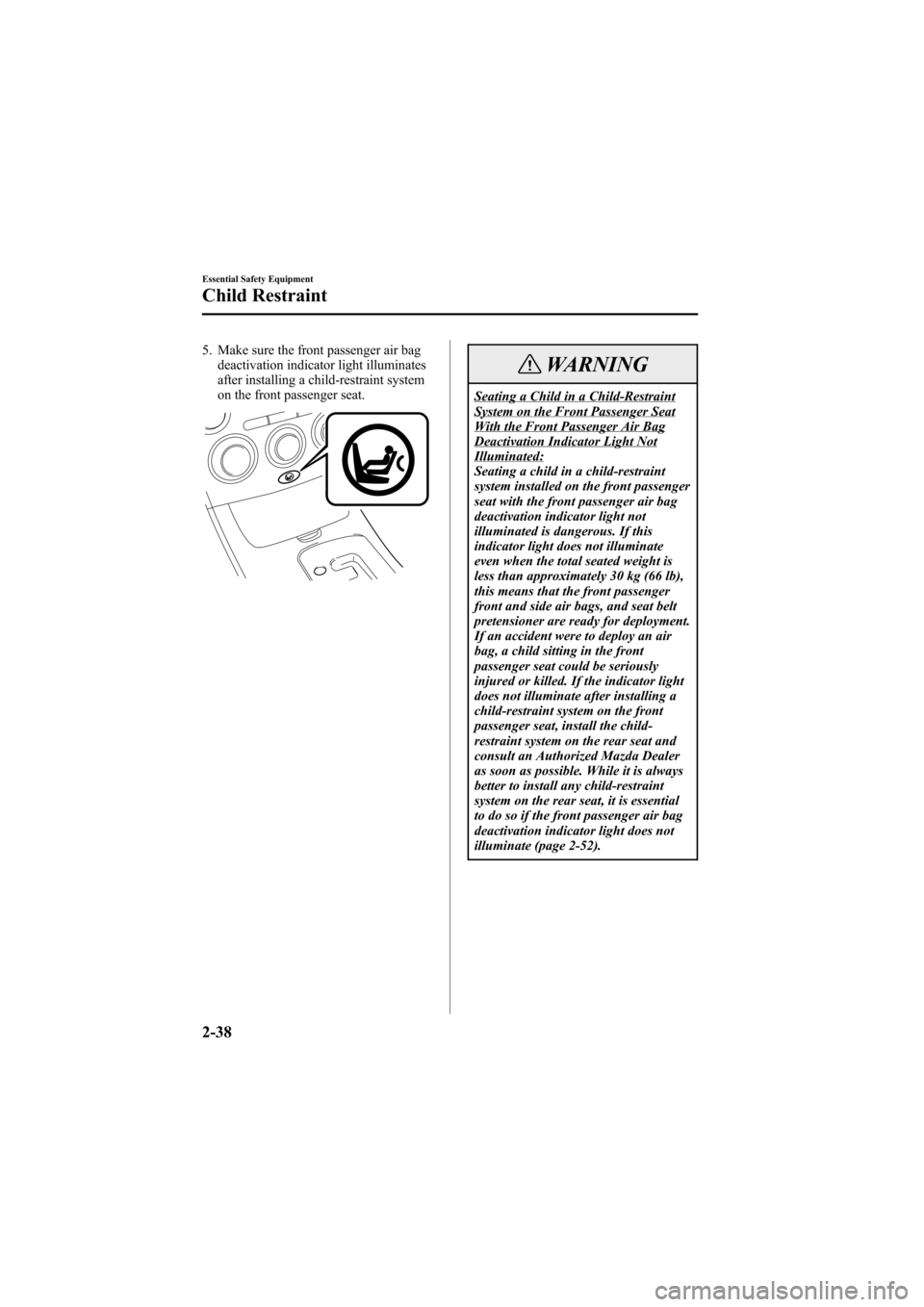
Black plate (52,1)
5. Make sure the front passenger air bag
deactivation indicator light illuminates
after installing a child-restraint system
on the front passenger seat.
WARNING
Seating a Child in a Child-RestraintSystem on the Front Passenger SeatWith the Front Passenger Air BagDeactivation Indicator Light NotIlluminated:
Seating a child in a child-restraint
system installed on the front passenger
seat with the front passenger air bag
deactivation indicator light not
illuminated is dangerous. If this
indicator light does not illuminate
even when the total seated weight is
less than approximately 30 kg (66 lb),
this means that the front passenger
front and side air bags, and seat belt
pretensioner are ready for deployment.
If an accident were to deploy an air
bag, a child sitting in the front
passenger seat could be seriously
injured or killed. If the indicator light
does not illuminate after installing a
child-restraint system on the front
passenger seat, install the child-
restraint system on the rear seat and
consult an Authorized Mazda Dealer
as soon as possible. While it is always
better to install any child-restraint
system on the rear seat, it is essential
to do so if the front passenger air bag
deactivation indicator light does not
illuminate (page 2-52).
2-38
Essential Safety Equipment
Child Restraint
Mazda6_8T56-EC-04G_Edition2 Page52
Monday, November 15 2004 4:32 PM
Form No.8T56-EC-04G
Page 53 of 340
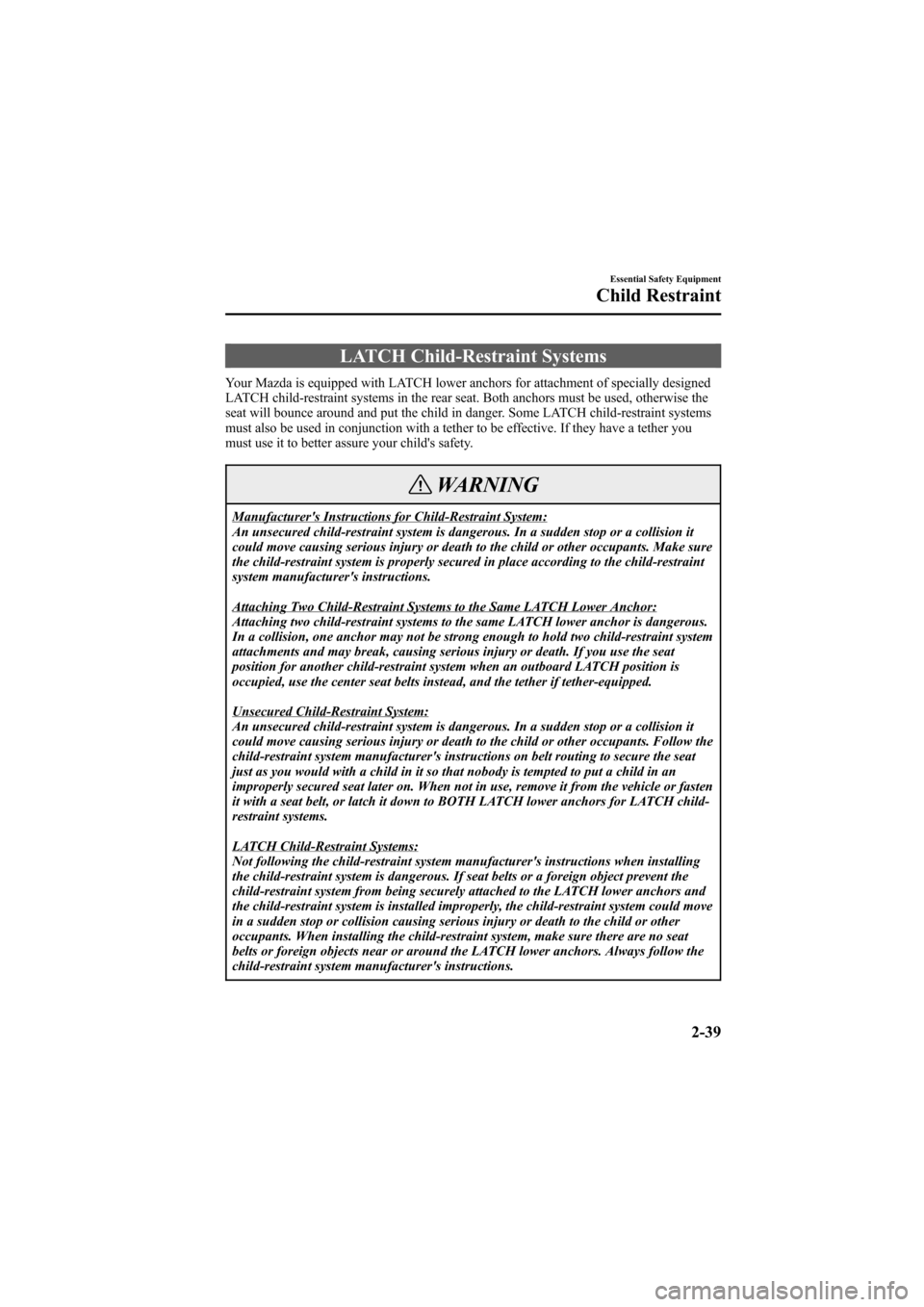
Black plate (53,1)
LATCH Child-Restraint Systems
Your Mazda is equipped with LATCH lower anchors for attachment of specially designed
LATCH child-restraint systems in the rear seat. Both anchors must be used, otherwise the
seat will bounce around and put the child in danger. Some LATCH child-restraint systems
must also be used in conjunction with a tether to be effective. If they have a tether you
must use it to better assure your child's safety.
WARNING
Manufacturer's Instructions for Child-Restraint System:
An unsecured child-restraint system is dangerous. In a sudden stop or a collision it
could move causing serious injury or death to the child or other occupants. Make sure
the child-restraint system is properly secured in place according to the child-restraint
system manufacturer's instructions.
Attaching Two Child-Restraint Systems to the Same LATCH Lower Anchor:
Attaching two child-restraint systems to the same LATCH lower anchor is dangerous.
In a collision, one anchor may not be strong enough to hold two child-restraint system
attachments and may break, causing serious injury or death. If you use the seat
position for another child-restraint system when an outboard LATCH position is
occupied, use the center seat belts instead, and the tether if tether-equipped.
Unsecured Child-Restraint System:
An unsecured child-restraint system is dangerous. In a sudden stop or a collision it
could move causing serious injury or death to the child or other occupants. Follow the
child-restraint system manufacturer's instructions on belt routing to secure the seat
just as you would with a child in it so that nobody is tempted to put a child in an
improperly secured seat later on. When not in use, remove it from the vehicle or fasten
it with a seat belt, or latch it down to BOTH LATCH lower anchors for LATCH child-
restraint systems.
LATCH Child-Restraint Systems:
Not following the child-restraint system manufacturer's instructions when installing
the child-restraint system is dangerous. If seat belts or a foreign object prevent the
child-restraint system from being securely attached to the LATCH lower anchors and
the child-restraint system is installed improperly, the child-restraint system could move
in a sudden stop or collision causing serious injury or death to the child or other
occupants. When installing the child-restraint system, make sure there are no seat
belts or foreign objects near or around the LATCH lower anchors. Always follow the
child-restraint system manufacturer's instructions.
Essential Safety Equipment
Child Restraint
2-39
Mazda6_8T56-EC-04G_Edition2 Page53
Monday, November 15 2004 4:32 PM
Form No.8T56-EC-04G
Page 54 of 340
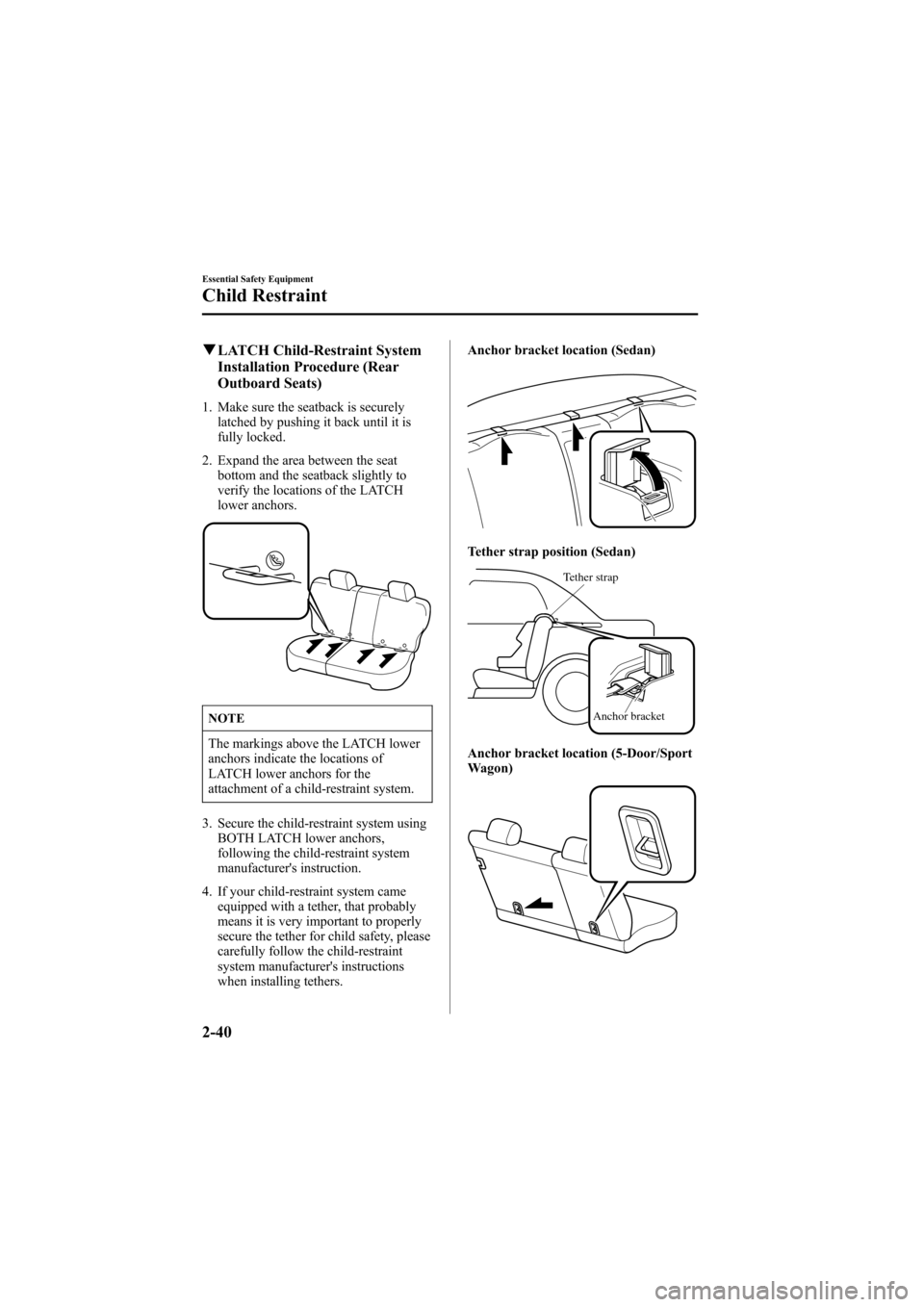
Black plate (54,1)
qLATCH Child-Restraint System
Installation Procedure (Rear
Outboard Seats)
1. Make sure the seatback is securely
latched by pushing it back until it is
fully locked.
2. Expand the area between the seat
bottom and the seatback slightly to
verify the locations of the LATCH
lower anchors.
NOTE
The markings above the LATCH lower
anchors indicate the locations of
LATCH lower anchors for the
attachment of a child-restraint system.
3. Secure the child-restraint system using
BOTH LATCH lower anchors,
following the child-restraint system
manufacturer's instruction.
4. If your child-restraint system came
equipped with a tether, that probably
means it is very important to properly
secure the tether for child safety, please
carefully follow the child-restraint
system manufacturer's instructions
when installing tethers.Anchor bracket location (Sedan)
Tether strap position (Sedan)
Tether strap
Anchor bracket
Anchor bracket location (5-Door/Sport
Wagon)
2-40
Essential Safety Equipment
Child Restraint
Mazda6_8T56-EC-04G_Edition2 Page54
Monday, November 15 2004 4:32 PM
Form No.8T56-EC-04G
Page 55 of 340
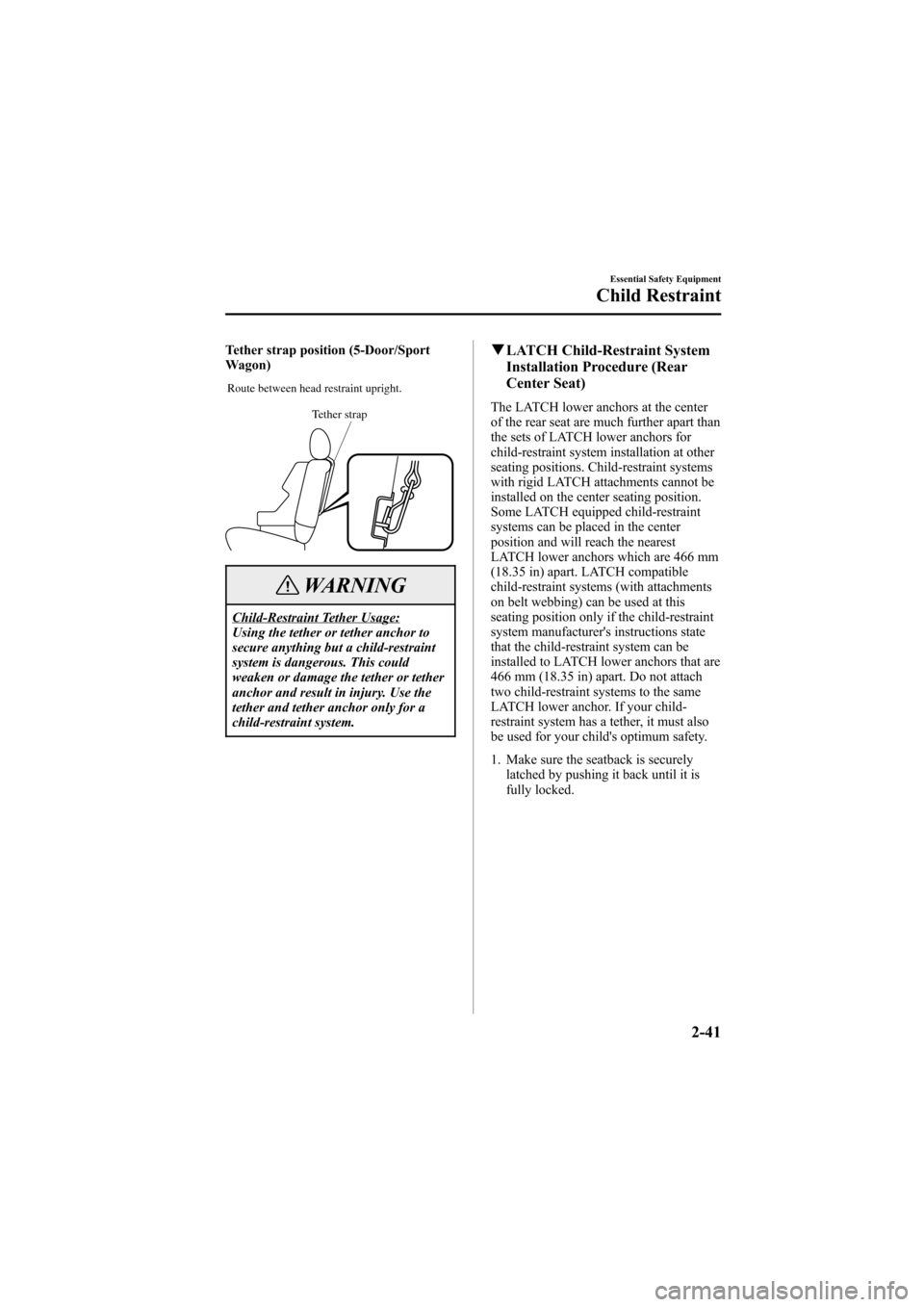
Black plate (55,1)
Tether strap position (5-Door/Sport
Wagon)
Tether strap Route between head restraint upright.
WARNING
Child-Restraint Tether Usage:
Using the tether or tether anchor to
secure anything but a child-restraint
system is dangerous. This could
weaken or damage the tether or tether
anchor and result in injury. Use the
tether and tether anchor only for a
child-restraint system.
qLATCH Child-Restraint System
Installation Procedure (Rear
Center Seat)
The LATCH lower anchors at the center
of the rear seat are much further apart than
the sets of LATCH lower anchors for
child-restraint system installation at other
seating positions. Child-restraint systems
with rigid LATCH attachments cannot be
installed on the center seating position.
Some LATCH equipped child-restraint
systems can be placed in the center
position and will reach the nearest
LATCH lower anchors which are 466 mm
(18.35 in) apart. LATCH compatible
child-restraint systems (with attachments
on belt webbing) can be used at this
seating position only if the child-restraint
system manufacturer's instructions state
that the child-restraint system can be
installed to LATCH lower anchors that are
466 mm (18.35 in) apart. Do not attach
two child-restraint systems to the same
LATCH lower anchor. If your child-
restraint system has a tether, it must also
be used for your child's optimum safety.
1. Make sure the seatback is securely
latched by pushing it back until it is
fully locked.
Essential Safety Equipment
Child Restraint
2-41
Mazda6_8T56-EC-04G_Edition2 Page55
Monday, November 15 2004 4:32 PM
Form No.8T56-EC-04G
Page 56 of 340

Black plate (56,1)
2. Expand the area between the seat
bottom and the seatback slightly to
verify the locations of the LATCH
lower anchors.
NOTE
The markings above the LATCH lower
anchors indicate the locations of
LATCH lower anchors for the
attachment of a child-restraint system.
3. Secure the child-restraint system using
BOTH LATCH lower anchors,
following the child-restraint system
manufacturer's instructions.
4. If your child-restraint system came
equipped with a tether, that probably
means it is very important to properly
secure the tether for child safety, please
carefully follow the child-restraint
system manufacturer's instructions
when installing tethers.Anchor bracket location (Sedan)
Tether strap position (Sedan)
Tether strap
Anchor bracket
Anchor bracket location and tether
strap position (5-Door)
Tether strap Anchor
bracket
2-42
Essential Safety Equipment
Child Restraint
Mazda6_8T56-EC-04G_Edition2 Page56
Monday, November 15 2004 4:32 PM
Form No.8T56-EC-04G
Page 57 of 340
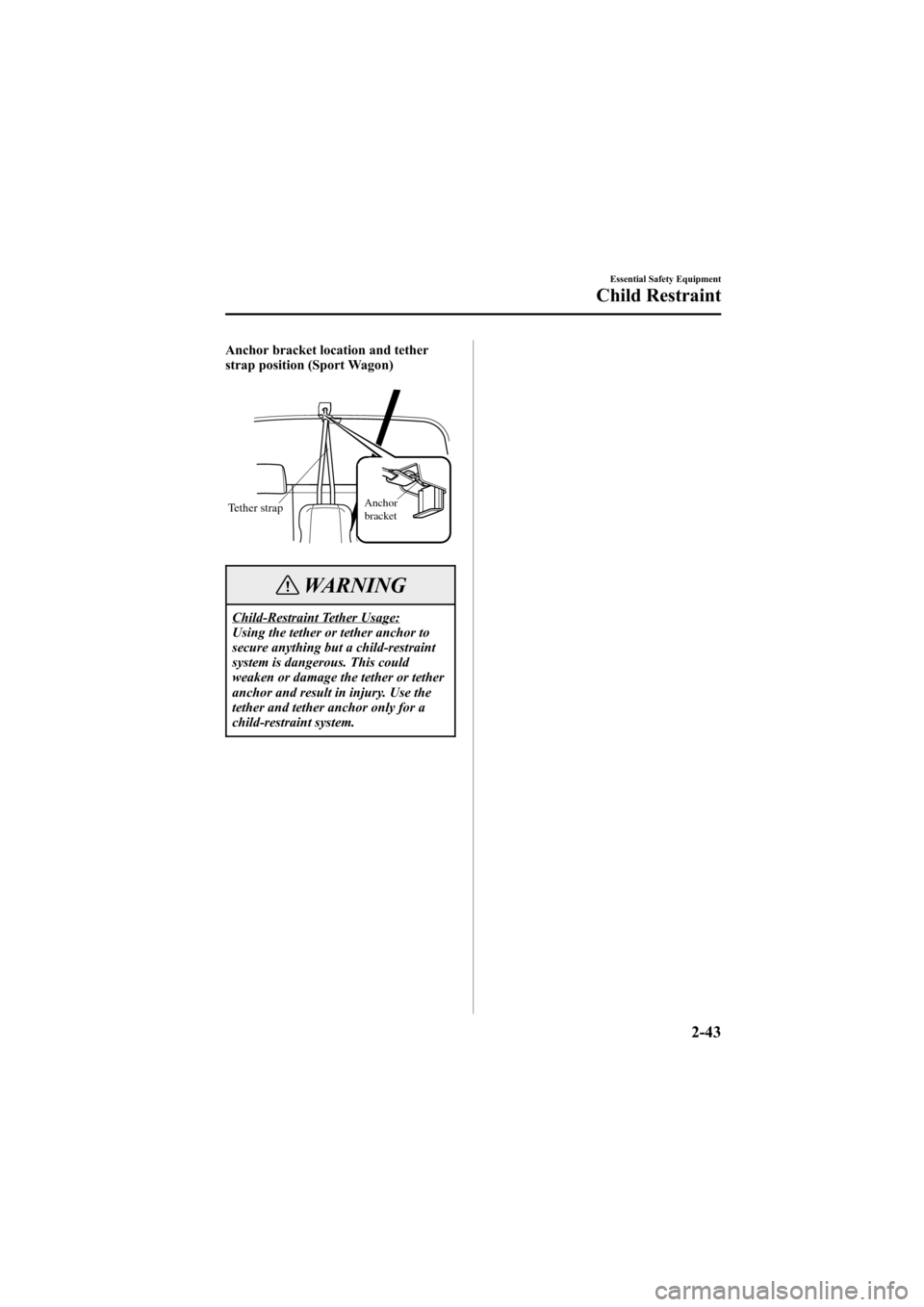
Black plate (57,1)
Anchor bracket location and tether
strap position (Sport Wagon)
Anchor
bracketTether strap
WARNING
Child-Restraint Tether Usage:
Using the tether or tether anchor to
secure anything but a child-restraint
system is dangerous. This could
weaken or damage the tether or tether
anchor and result in injury. Use the
tether and tether anchor only for a
child-restraint system.
Essential Safety Equipment
Child Restraint
2-43
Mazda6_8T56-EC-04G_Edition2 Page57
Monday, November 15 2004 4:32 PM
Form No.8T56-EC-04G
Page 58 of 340
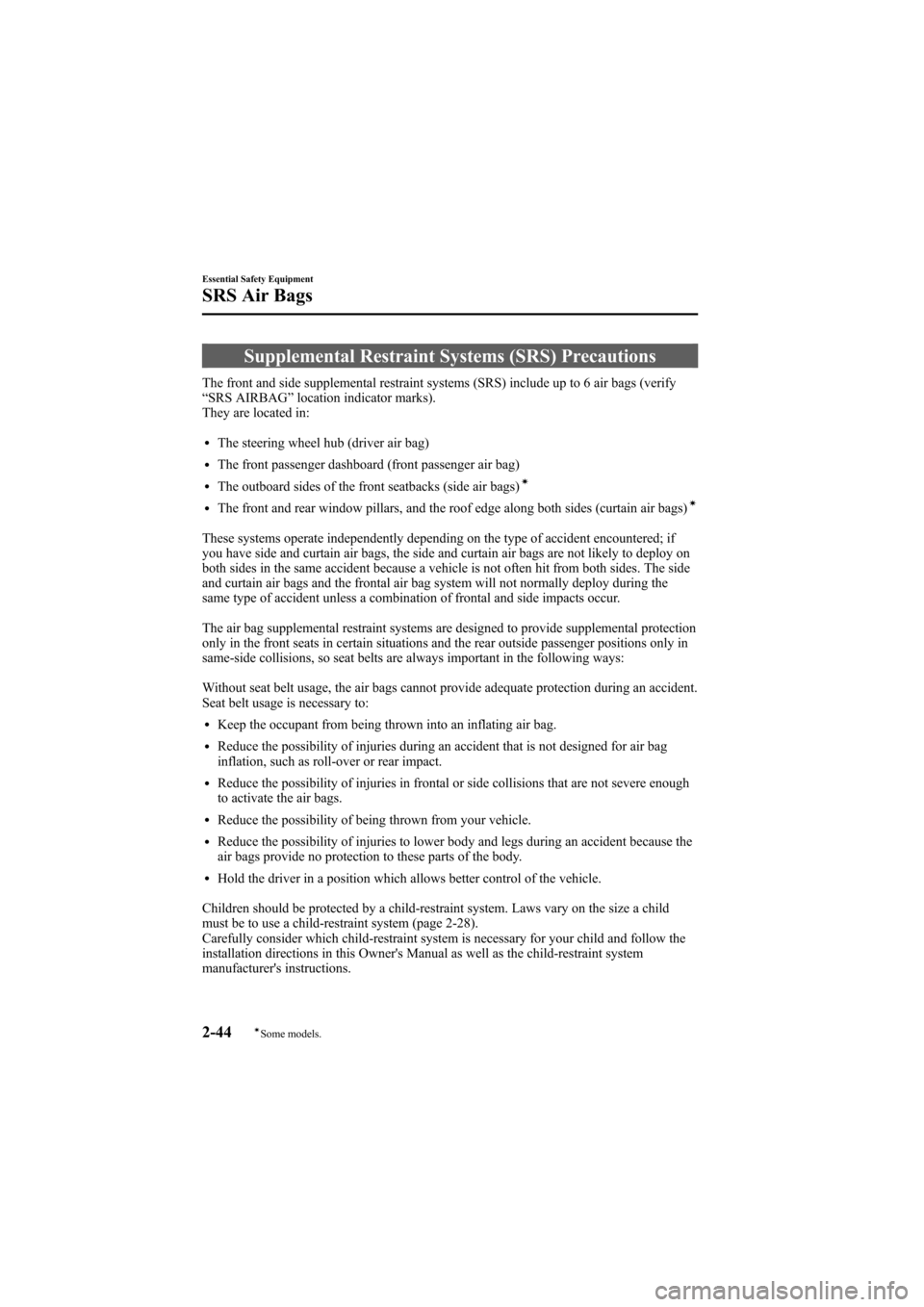
Black plate (58,1)
Supplemental Restraint Systems (SRS) Precautions
The front and side supplemental restraint systems (SRS) include up to 6 air bags (verify
“SRS AIRBAG”location indicator marks).
They are located in:
lThe steering wheel hub (driver air bag)
lThe front passenger dashboard (front passenger air bag)
lThe outboard sides of the front seatbacks (side air bags)í
lThe front and rear window pillars, and the roof edge along both sides (curtain air bags)í
These systems operate independently depending on the type of accident encountered; if
you have side and curtain air bags, the side and curtain air bags are not likely to deploy on
both sides in the same accident because a vehicle is not often hit from both sides. The side
and curtain air bags and the frontal air bag system will not normally deploy during the
same type of accident unless a combination of frontal and side impacts occur.
The air bag supplemental restraint systems are designed to provide supplemental protection
only in the front seats in certain situations and the rear outside passenger positions only in
same-side collisions, so seat belts are always important in the following ways:
Without seat belt usage, the air bags cannot provide adequate protection during an accident.
Seat belt usage is necessary to:
lKeep the occupant from being thrown into an inflating air bag.
lReduce the possibility of injuries during an accident that is not designed for air bag
inflation, such as roll-over or rear impact.
lReduce the possibility of injuries in frontal or side collisions that are not severe enough
to activate the air bags.
lReduce the possibility of being thrown from your vehicle.
lReduce the possibility of injuries to lower body and legs during an accident because the
air bags provide no protection to these parts of the body.
lHold the driver in a position which allows better control of the vehicle.
Children should be protected by a child-restraint system. Laws vary on the size a child
must be to use a child-restraint system (page 2-28).
Carefully consider which child-restraint system is necessary for your child and follow the
installation directions in this Owner's Manual as well as the child-restraint system
manufacturer's instructions.
2-44
Essential Safety Equipment
íSome models.
SRS Air Bags
Mazda6_8T56-EC-04G_Edition2 Page58
Monday, November 15 2004 4:32 PM
Form No.8T56-EC-04G
Page 59 of 340
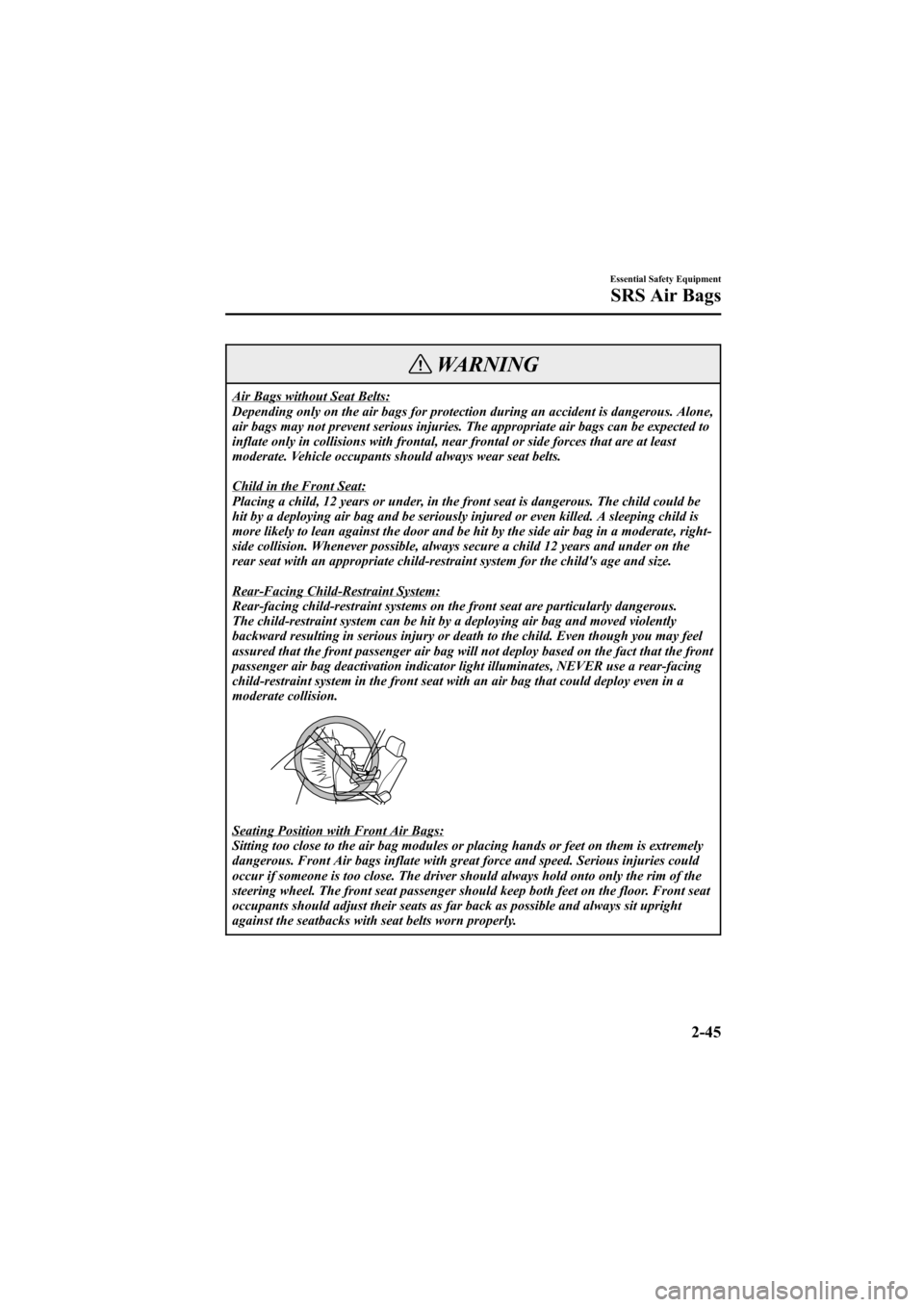
Black plate (59,1)
WARNING
Air Bags without Seat Belts:
Depending only on the air bags for protection during an accident is dangerous. Alone,
air bags may not prevent serious injuries. The appropriate air bags can be expected to
inflate only in collisions with frontal, near frontal or side forces that are at least
moderate. Vehicle occupants should always wear seat belts.
Child in the Front Seat:
Placing a child, 12 years or under, in the front seat is dangerous. The child could be
hit by a deploying air bag and be seriously injured or even killed. A sleeping child is
more likely to lean against the door and be hit by the side air bag in a moderate, right-
side collision. Whenever possible, always secure a child 12 years and under on the
rear seat with an appropriate child-restraint system for the child's age and size.
Rear-Facing Child-Restraint System:
Rear-facing child-restraint systems on the front seat are particularly dangerous.
The child-restraint system can be hit by a deploying air bag and moved violently
backward resulting in serious injury or death to the child. Even though you may feel
assured that the front passenger air bag will not deploy based on the fact that the front
passenger air bag deactivation indicator light illuminates, NEVER use a rear-facing
child-restraint system in the front seat with an air bag that could deploy even in a
moderate collision.
Seating Position with Front Air Bags:
Sitting too close to the air bag modules or placing hands or feet on them is extremely
dangerous. Front Air bags inflate with great force and speed. Serious injuries could
occur if someone is too close. The driver should always hold onto only the rim of the
steering wheel. The front seat passenger should keep both feet on the floor. Front seat
occupants should adjust their seats as far back as possible and always sit upright
against the seatbacks with seat belts worn properly.
Essential Safety Equipment
SRS Air Bags
2-45
Mazda6_8T56-EC-04G_Edition2 Page59
Monday, November 15 2004 4:32 PM
Form No.8T56-EC-04G
Page 60 of 340
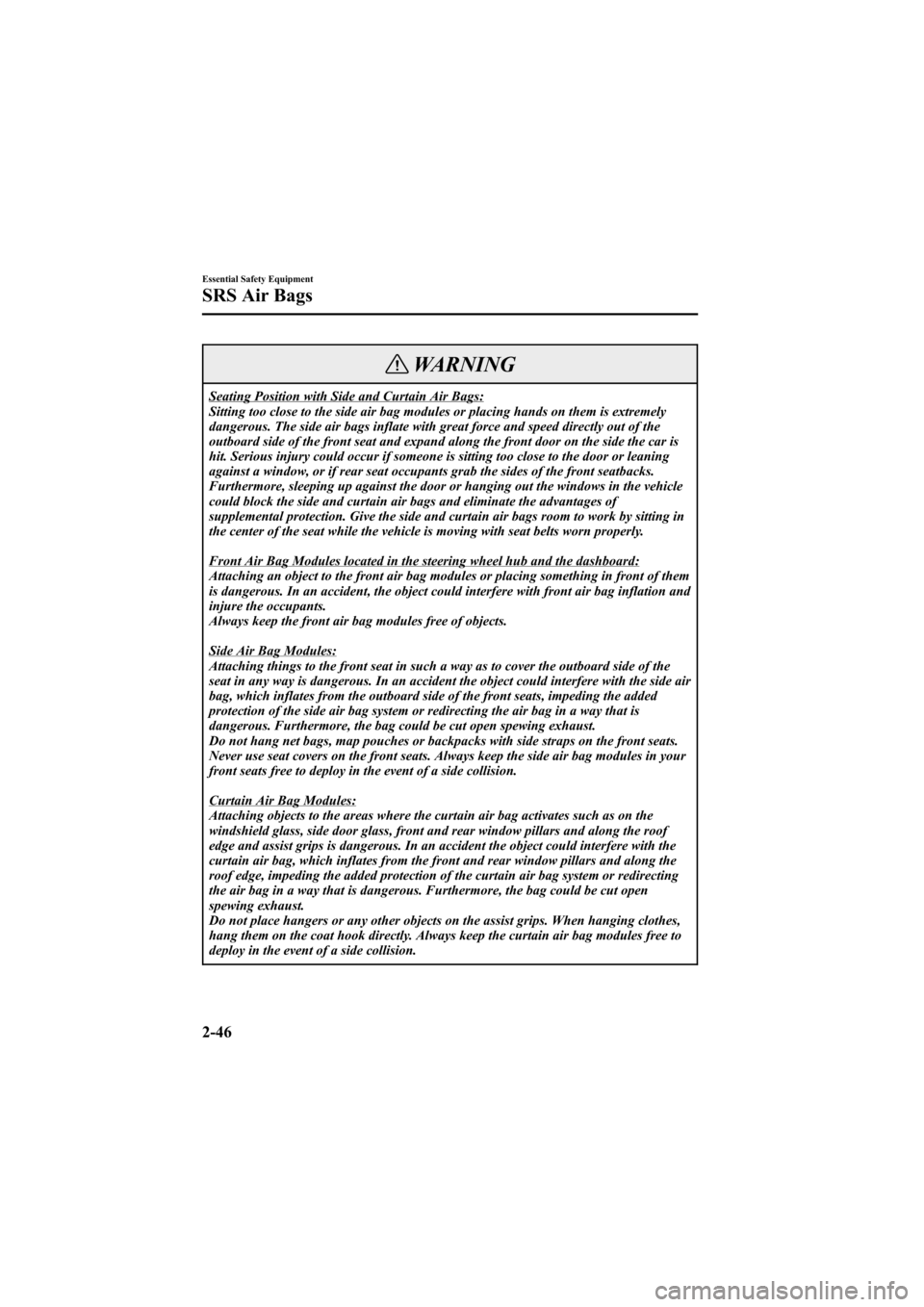
Black plate (60,1)
WARNING
Seating Position with Side and Curtain Air Bags:
Sitting too close to the side air bag modules or placing hands on them is extremely
dangerous. The side air bags inflate with great force and speed directly out of the
outboard side of the front seat and expand along the front door on the side the car is
hit. Serious injury could occur if someone is sitting too close to the door or leaning
against a window, or if rear seat occupants grab the sides of the front seatbacks.
Furthermore, sleeping up against the door or hanging out the windows in the vehicle
could block the side and curtain air bags and eliminate the advantages of
supplemental protection. Give the side and curtain air bags room to work by sitting in
the center of the seat while the vehicle is moving with seat belts worn properly.
Front Air Bag Modules located in the steering wheel hub and the dashboard:
Attaching an object to the front air bag modules or placing something in front of them
is dangerous. In an accident, the object could interfere with front air bag inflation and
injure the occupants.
Always keep the front air bag modules free of objects.
Side Air Bag Modules:
Attaching things to the front seat in such a way as to cover the outboard side of the
seat in any way is dangerous. In an accident the object could interfere with the side air
bag, which inflates from the outboard side of the front seats, impeding the added
protection of the side air bag system or redirecting the air bag in a way that is
dangerous. Furthermore, the bag could be cut open spewing exhaust.
Do not hang net bags, map pouches or backpacks with side straps on the front seats.
Never use seat covers on the front seats. Always keep the side air bag modules in your
front seats free to deploy in the event of a side collision.
Curtain Air Bag Modules:
Attaching objects to the areas where the curtain air bag activates such as on the
windshield glass, side door glass, front and rear window pillars and along the roof
edge and assist grips is dangerous. In an accident the object could interfere with the
curtain air bag, which inflates from the front and rear window pillars and along the
roof edge, impeding the added protection of the curtain air bag system or redirecting
the air bag in a way that is dangerous. Furthermore, the bag could be cut open
spewing exhaust.
Do not place hangers or any other objects on the assist grips. When hanging clothes,
hang them on the coat hook directly. Always keep the curtain air bag modules free to
deploy in the event of a side collision.
2-46
Essential Safety Equipment
SRS Air Bags
Mazda6_8T56-EC-04G_Edition2 Page60
Monday, November 15 2004 4:32 PM
Form No.8T56-EC-04G